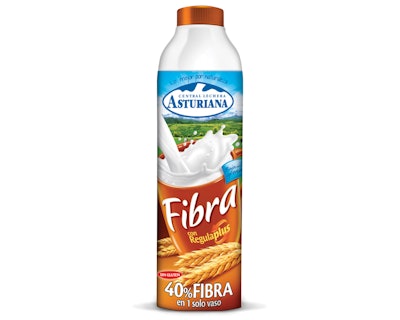
Corporación Alimentaria Peñsanta S.A. (CAPSA) is the largest dairy in Spain and is ranked number three on the Reputation Institute’s list of Spanish companies with the best reputations. Its products are market leaders in the milk, cream, and butter categories, netting the company €9.8 million in profits 2011. One of the keys to its success, explains Manuel Reinierio, head of CAPSA communications, is its focus on systematized innovation. “Brand innovation is the path for our growth,” he says.
In April 2011, CAPSA blew the top off dairy innovation, becoming the first company worldwide to launch a new package structure that combines the body of a liquid carton with the top of a plastic bottle: the Tetra Evero® Aseptic (TEA) from Tetra Pak. Designed to combine the environmental advantages of a paperboard-based carton with the easy handling and pouring benefits of a bottle, the TEA is produced using patented manufacturing technologies, including an industry-first sterilization technique and advanced injection-molding processes, found in the Tetra Pak A6 iLine.
Working with Tetra Pak on an accelerated schedule, CAPSA began installation of the Tetra Pak A6 iLine in late January 2011, and within six weeks, it began aseptic tests for its new line of three Asturiana brand enriched milk products. In April 2011, the product line made its debut in Spanish supermarkets, with 1.5 million liters packaged in 1,000-mL TEA carton bottles. In mid-April, Tetra Pak delivered a second Tetra Pak A6 iLine to another of CAPSA’s plants in Spain.
“For our most strategic project, we knew we had to have Tetra Evero Aseptic,” says CAPSA managing director Jose Armando Tellado. “This package expresses evolution, a very advanced step in comparison with today’s packages. Tetra Evero Aseptic is the perfect match of a high value-added product with a highly developed package. To me, this is doubtlessly a winner.”
Innovation at the heart of Apollo
CAPSA, with headquarters on the northern coast of Spain in Oviedo, was formed in 1997 with the merging of three leading dairy companies—Central Lechera Asturiana, ATO, and Larsa. Fifty-six percent of the company is owned by a cooperative of 8,000 farmers from across Asturias (North of Spain) that supplies the company’s milk. CAPSA operates eight facilities on the Iberian Peninsula, producing milk (79%), cream and butter (8%), cheese (5%), yogurts and desserts (5%), and other dairy products (3%). Seventy percent of its business is private-label, with its products sold primarily in Spain.
As explained by CAPSA’s Reinierio during a visit by Packaging World to the Oviedo facility, innovation—in both products and packaging—is one of CAPSA’s main strategies for growth. In 1999, the company launched the Tetra Brik Aseptic carton, leading to a sales growth of 28%; in 2006, its plastic milk bottle contributed to a 24% rate of growth, while the market decreased by 3%; and in 2010, it introduced its Botequilla semi-liquid butter brand, for 32.6% growth in its Asturiana Butter category. “Innovation is very important for the future of this company,” reiterates Reinierio, “and for the future of the brand.”
In 2011, CAPSA embarked upon the Apollo Project to expand its offerings beyond commodity milk products and take advantage of the fast-growing functional milk market. The goal is to increase the company’s share in the total milk market from 13% to 20% in five years. As part of the project’s €100 million investment, CAPSA developed the Asturiana line of fortified ambient milk products, including Fibra, containing two natural fibers; Naturcol, to help reduce cholesterol; and Jalea Vital, to help strengthen the immune system. “While we are a leader in the classical milk segment, the challenge has been in value-added milks,” says Reinierio. “That is the reason Apollo was created.”
For its debut in the functional milk market, CAPSA required a package that was as innovative as the product and that also addressed its other core commitments of sustainability and food safety. The TEA matched all of CAPSA’s requirements.
In terms of innovation, the new package combines the strong sensory appeal of a bottle-shaped carton made of a paperboard sleeve with the handling and pouring advantages that come with an injection-molded top and cap. The package offers 360-deg printing around the body, with high-impact flexo-printed graphics. The ergonomic shape makes the bottle easy to hold and to pour, and its 38-mm closure—options include the TrueOpening O38A one-step closure, or the H38A two-step closure (used by CAPSA)—provides tamper-evidence and resealability. Designed primarily for ambient white milk, the TEA also provides up to a six-month shelf life for non oxygen-sensitive products.
According to consumer research conducted by Tetra Pak in 2007, respondents prefer the TEA package versus PET and high-density polyethylene dairy containers on virtually all consumer attributes, saying it is more appealing, higher quality, easier to store and pour, easier to dispose of, and more environmentally friendly, and it preserves freshness better.
The TEA carton body is a multilayer laminated construction of polyethylene, aluminum foil, and paperboard, printed in up to six colors. It is supplied in rollstock, converted by Tetra Pak’s Lund, Sweden, facility. The neck material is made from a white low-density PE, while the closure—available in eight colors—is made from polypropylene.
As for the environmental profile of the TEA, in a peer-reviewed Life Cycle Analysis conducted by Ifeu (Institute for Energy and Environmental Research) in Germany in 2010, the package showed a 24% to 30% lower carbon footprint versus PET and HDPE containers of a similar weight. The body of the carton bottle is constructed of Forest Stewardship Council™-certified paperboard, and the components of the container can be easily separated by the consumer for recycling.
New technology ensures sterility
As mentioned, CAPSA’s success relies heavily on its commitment to food safety, which it pursues through a range of technologies. The Tetra Pak A6 iLine meets CAPSA’s food safety expectations through the use of a completely new gas-phase sterilization method for the uniquely shaped TEA. According to Tetra Pak, with a traditional brick-shaped aseptic carton, materials come “flat-packed,” meaning they can be aseptically sterilized before they are formed into shape. In this process, rolls of carton material pass through a hot liquid hydrogen peroxide bath that kills off bacteria. The hydrogen peroxide is then removed from the packaging material using pressure rollers and hot air. However, the TEA is preformed, not flat-packed, requiring a different approach.
Notes Tetra Pak, most existing technologies for sterilizing preformed shapes rely on a gas-condensation process, where gas is allowed to condensate on the material surface. However, this requires that it remains within very specific operational limits, which can be complex and difficult to control. The alternative gas-phase sterilization approach, where packages are preheated to avoid condensation, offers benefits, but Tetra Pak says it had never been applied to a carton bottle before.
To address the challenges of a totally new shape, Tetra Pak engineers applied the gas-phase sterilization technique in new ways. Packages pass through a unique aseptic chamber in pairs where they are exposed to hydrogen peroxide in gas phase. Hydrogen peroxide comes into contact with the whole preformed package, both inside and out, removing any contaminants that might have been present before entering the aseptic chamber. The gas is then vented from the package.
To deliver this solution, Tetra Pak used advanced modeling techniques to develop a completely new form of aseptic chamber, in which a uni-directional airflow creates a “virtual barrier” between the sterile zone and the non-sterile zone, protecting the critical aseptic area.
In March 2011, when CAPSA ran the first sterility tests of its new Tetra Pak A6 iLine, installed at its Oviedo facility, the final result was a defect rate of zero out of more than 10,000 packs. “The results of the aseptic tests were amazing,” says José Manuel Cobo, technical key account manager for Tetra Pak Iberia, who led the TEA project team at CAPSA. “I have never seen anything like this for deployment of a prototype. Everything was in perfect aseptic condition.”
New manufacturing technologies
The Tetra Pak A6 iLine turnkey system, which includes the A6 filling machine and integration with secondary packaging equipment, was delivered to CAPSA’s Oviedo facility in early 2011, with the modular filler alone requiring eight trailer trucks. The A6 dual-line filling machine was designed with factory space savings in mind, taking up at least 50% less space than a traditional PET filling line, according to Tetra Pak. The two-story unit measures 13.7 x 2.1 x 4.7 meters and is constructed using a modular architecture that facilitates product extensions. The machine comprises two main sections—the RTF (Ready To Fill) area, and the SFS (Sterilization Filling Sealing) section—and can produce 10,000 packs/hr.
One of the advantages of the A6 line, according to Cobo, is its fully automatic cleaning system, which allows operators to clean the machine in half the time it takes for a PET filling line—from 10 hours down to five—resulting in high uptime. The machine is designed to run 40 hours between cleaning and sterilization, although CAPSA cleans it more frequently, says Cobo.
At the Oviedo facility, a separate room was constructed to hold the A6 filler. During operation of the machine, rolls of printed carton material (7,000/roll) are loaded manually into the machine. The dual-line filler accommodates two rolls on each side; when one roll is finished, the system automatically changes over to the next.
In the first process, a strip of plastic is applied to the edge of the rollstock material that will later weld the two sides of the package together. Next, the material is cut into individual sheets from which the cartons will be formed. Sheets are then wrapped around a mandrel wheel onto which the caps have been applied, and the edges of the carton are welded together using electronic high-frequency induction sealing. The mandrel with cap and carton body is then indexed to the injection-molding station, where the plastic bottle portion of the package is constructed.
For this step in the process, Tetra Pak developed a new injection-molding process. Notes Tetra Pak, a typical injection-molding process takes from three to six seconds, but by simplifying the process, Tetra Pak reduced that time to less than 1.5 sec. Simplification was achieved by creating a mold with only two parts—an inner and outer mold—and integrating the injection-molding module into the filling machine itself. In addition, the carton sleeve is present in the mold when the hot plastic is injected, meaning that the three separate components—plastic cap, plastic top, and carton body—are fused and sealed as part of the process.
According to Tetra Pak, while the mold is simple, the engineering required to deliver it was not. “One of the most complex challenges involved development of the ‘hot runner,’ which injects the plastic into the outer mold,” says the company. “To ensure consistent quality, the plastic must be injected symmetrically and heated to 210°C. If the temperature is too low, then the seal might leak; too hot and the molded top might deform.”
Applying a systematic failure-mode approach to identify any factors that could impact the equipment, Tetra Pak engineers and an external specialist created a unique hot runner using four inlet valves to deliver the plastic symmetrically and at precisely the right temperature. The resulting system allows for the manufacture of very thin-walled plastic tops with reduced running time and the need for very low forces. Low force reduces the injection-molding cycle time, which increases capacity while reducing wear.
After the carton, bottle, and cap are fused together, the preformed package moves to the machine’s aseptic chamber, where it is rotated so its open end is facing up, and the carton bottle is sterilized using the process described earlier. After the peroxide gas is vented from the package (nine chimneys on top of the A6 machine evacuate the hot air and filtered gas), the carton bottle is filled via four filling heads, with each head filling one quarter of the container. This method eliminates bubbles and reduces splashing, which would make the bottom of the carton wet and difficult to seal. Finally, in a two-stage process, the bottom flaps of the carton are folded, and the carton is then sealed using HF welding. Filled, sealed packages are then rotated 180 deg to stand upright and exit the machine onto outfeed conveyors that keep the output of the two sides of the machine separate.
Immediately after exiting the filling machine, packages are coded via two Videojet ink-jet coding machines, with the date of production, the number of the line, and the hour, minute, and second the product was filled, for quality control purposes. Every 20 minutes, the conveyor automatically diverts a package to a separate lane, for package integrity and microbiological product testing.
After coding, packages exit the filling room and move toward two ACHX 30 vertical spiral conveyors, designed for Tetra Pak by Hartness. The units provide first in first out accumulating and can hold up to five minutes’ worth of product. The finishing touch to the innovative packaging line is a secondary packaging system designed specifically for CAPSA.
Custom secondary packaging solution
As Tetra Pak’s Cobo explains, while in the development phase of the full TEA solution, Tetra Pak tested eight different secondary packaging solutions that included combinations of film, pads, trays, and vertical inserts. Pallet-wrapping options comprised a shrink-wrap hood, a stretch hood, and a stretch wrap. CAPSA’s preference was to pack the carton bottles in trays, unitized with shrink film, to reduce the amount of secondary paperboard packaging material required.
To create this solution, Tetra Pak worked with GamPack to create the FW68NDS CB. The system erects a preprinted tray around six bottles, wraps the multipack with shrink film, and carries the bundle through a shrink tunnel, creating 50 packs/min. The system is also capable of producing four- and eight-count multipacks. At CAPSA, the shrink-wrapped bundle is then carried by conveyor to a handle applicator from GamPack sister company Twin Pack.
After handles are applied to the multipacks, they are carried by conveyor to a palletizer from OCME that can produce loads of 720 units in five layers. According to Cobo, Tetra Pak was very mindful when selecting a palletizing system that the semi-cylindrical shape of the TEA makes it less sturdy than a square carton. “We considered this factor in the design of all of our equipment,” he notes.
The final machine in the line is a stretch-hood pallet wrapper from Thimon. In performance tests by Tetra Pak, the stretch hood was found to work well with the TEA, offering high protection, without the damage to pallet corners found with stretch wrapping.
Standout success
By the time of PW’s visit to CAPSA’s Oviedo plant in spring 2013, the Tetra Pak A6 iLine had accumulated 4,000 production hours, and is now producing 400,000 carton bottles/wk. In July 2011, the company’s Vidreres, Spain, plant began market launch of products produced on the A6 line, as well. Since then, two more machines have been installed in other dairies in Europe, with Cobo’s assistance.
According to sales figures, CAPSA’s decision to be a leader in innovation by being the first to debut the Tetra Evero Aseptic has been well received by consumers. As Tellado notes, “CAPSA decided to use Tetra Evero Aseptic because it is an innovative and unique product. There is no product like it on the market…. When I saw Tetra Evero Aseptic, I wanted to be the first to have this container on the market. I see this as a product that truly stands out, which is what we wanted.”





























